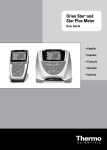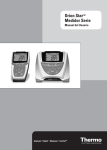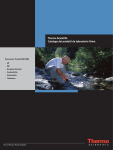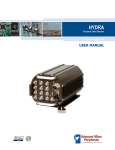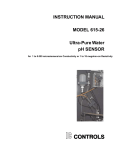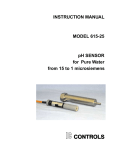Download DAVIS SensorLink Instruction manual
Transcript
pH Orion 8003, 8165, 8172, 8175 Orion ROSS ® Sure-Flow Electrodes INSTRUCTION MANUAL Analyze • Detect • Measure • Control™ ™ AQUAfast, Cahn, EZ Flash, Ionalyzer, ionplus, KNIpHE, No Cal, ORION, perpHect, PerpHecT, PerpHecTion, pHISA, pHix, pHuture, Pure Water, Sage, Sensing the Future, SensorLink, ROSS Ultra, Sure-Flow, TEA Analyzer, Titrator PLUS, TURBO2 and Wine Master are registered trademarks of Thermo Electron Corporation. 1-888-pHAX-ION, A+, All in One, Aplus, AQUAsnap, AssuredAccuracy, AUTO-BAR, AUTO-CAL, AUTO DISPENSER, Auto-ID, AUTO-LOG, AUTO-READ, AUTO-STIR, Auto-Test, BOD AutoEZ, Cable-Free, CERTI-CAL, CISA, DataCOLLECT, DataPLUS, digital LogR, DirectCal, DuraProbe, Environmental Product Authority, Extra Easy/Extra Value, FAST QC, Flash Titration, Flash Titrator, GAP, GLPcal, GLPcheck, GLPdoc, ISEasy, KAP, LabConnect, LogR, Low Maintenance Triode, Minimum Stir Requirement, MSR, NISS, One-Touch, One-Touch Calibration, OneTouch Measurement, Optimum Results, Pentrode, pHuture MMS, pHuture Pentrode, pHuture Quatrode, pHuture Triode, Quatrode, QuiKcheK, rf link, ROSS, ROSS Resolution, SAOB, Smart CheK, Stacked, Stat Face, The Enhanced Lab, ThermaSense, Triode, TRIUMpH, Unbreakable pH, Universal Access are trademarks of Thermo. Guaranteed Success and The Technical Edge are service marks of Thermo. PerpHecT meters are protected by U.S. patent 6,168,707. PerpHecT ROSS are protected by U.S. patent 6,168,707. ORION Series A meters and 900A printer are protected by U.S. patents 5,108,578, 5,198,093 and German patents D334,208 and D346,753. Sure-Flow electrodes are protected by European Patent 278,979 and Canadian Patent 1,286,720. ionplus electrodes and Optimum Results solutions are protected by US Patent 5,830,338. ROSS Ultra electrodes have patents pending. ORION ORP Standard is protected by US Patent 6,350,367. ORION Series A conductivity meters are protected by US Patent 5,872,454. © Copyright 2003, Thermo Electron Corporation. All rights reserved. Question everything, and Analyze.Detect.Measure.Control are trademarks of Thermo Electron Corporation. The specifications, descriptions, drawings, ordering information and part numbers within this document are subject to change without notice. This publication supersedes all previous publications on this subject. TABLE OF CONTENTS General Information 1 Introduction Required Equipment Required Solutions 1 2 2 Using the Electrode 3 Electrode Preparation Sample Requirements Placement of Removable Bulb Guard Sure-Flow® Junction Measuring Hints pH Calibration & Measurement General Calibration Procedure Two-Buffer Calibration Single Buffer Calibration pH Measurement Electrode Maintenance Cleaning Electrode Removal of Membrane/Junction Deposits Electrode Storage Troubleshooting 3 4 5 5 6 7 7 7 8 8 8 8 9 9 11 Troubleshooting Guide Assistance 11 12 Electrode Characteristics 13 Temperature Effects Electrode Leak Rate Interferences 13 13 14 Warranty 15 Ordering Information 19 Specifications 21 GENERAL INFORMATION Introduction This manual contains instructions for the ROSS™ Sure-Flow® Series of pH electrodes. Operation and maintenance instructions for the following electrodes are included: Orion Description 8003 ROSS Sure-Flow Reference Half-Cell, glass body 8165 ROSS Sure-Flow Combination, epoxy body 8172 ROSS Sure-Flow Combination, glass body 8175 ROSS Sure-Flow Semi-Micro Combination, epoxy body ROSS Sure-Flow Electrodes provide a free-flowing sleeve junction especially designed for measurement in general pH samples as well as viscous or colloidal samples whenever best performance is desired. The junction can be cleaned easily between measurements; pressing down on the cap allows filling solution to flow through the junction, carrying away any contamination that may interfere with measurement. The Models 8165 and 8175 combine the Sure-Flow junction with a rugged epoxy body. A sleeve protects the pH sensing bulb and is removable for easy cleaning. The rugged epoxy body is resistant to strong acids and strong bases. It may be used intermittently in some organics. Polar organic compounds should be strictly avoided (Orion 8172BN is recommended for use in organics). The Ross series of electrodes provide readings stable to 0.01 pH in a buffer solution in less than 30 seconds, even in the extreme case of buffers varying from one another by 50 ˚C or more. Results are three to five times more precise than those obtained with conventional electrodes. ROSS Sure-Flow Electrodes are supplied with BNC connectors. Adaptors are available for conversion to U.S. Standard connectors. See Ordering Information, or consult the Thermo Electron Corporation Laboratory Products Catalog and price list. For more information contact your local Thermo Distributor, or call Thermo Customer Service. 1 Required Equipment Meter — Any Orion pH or ion-selective meter, or other pH/lSE meter with appropriate connectors. Electrode — Combination pH Electrode, or pH and Reference Electrode Half Cells. Use the Orion 8003 ROSS™ Sure-Flow® Reference Half Cell Electrode with a ROSS Half Cell. Thermometer — Readable to ± 0.5 °C. Beakers — Plastic or glass. Magnetic Stirrer — Suggested for precision measurements. Required Solutions pH Buffers - Two are recommended for precise measurement. The first near the electrode isopotential point (pH 7) and the second near the expected sample pH (e.g., pH 4 or 10). ROSS Internal Filling Solution — 3 M KCl, Orion 810007. Do not use any filling solution which contains silver. (Electrode damage may result.) filling hole Orion 8175 ROSS internal reference pH sensing bulb filling solution chamber Sure-Flow sleeve junction Figure 1: Orion 8172 ROSS Sure-Flow Combination 2 USING THE ELECTRODE Electrode Preparation 1. Remove the protective shipping cap from sensing element and save for storage. 2. Clean any salt deposits from exterior by rinsing with distilled water. 3. Uncover filling hole by removing plastic sleeve and add ROSS™ Internal Filling Solution, Orion 810007, to electrode. See Figure 2. To maintain an adequate flow rate, the level of filling solution must cover the end of coil and be at least one inch above the sample level when immersed. The filling hole should be open whenever the electrode is in use. 4. Thoroughly wet the junction by pressing down on the electrode cap and allowing some of the ROSS Internal Filling Solution to flow out of the electrode through the junction. Replenish lost filling solution. See Figure 3. 5. Shake down the electrode (as a clinical thermometer) to remove air bubbles. 6. Soak combination electrode and/or pH half cell in pH Electrode Storage Solution, Orion 910001, for one hour. Reference electrodes do not need to be soaked. If Orion pH Storage Solution is not available, use 200 mL pH 7 buffer to which about 1 g KCl has been added, as a temporary substitute. 7. Connect electrodes to meter. Figure 2: Filling the ROSS Sure-Flow Electrode 3 Sample Requirements One of the benefits of the ROSS™ pH Electrodes is that the filling solution composition may be changed depending on sample requirements because of the double junction construction. Do not use solutions containing silver. The ROSS pH Electrode Filling Solution, Orion 810007, is 3 M KCl. For solutions which precipitate in the presence of chloride ion, the ROSS pH Electrode could be filled with 10% KNO3, Orion 900003. In organic solutions a minimum of 20% water must be present in the sample. If there is a great deal of drift in organic solutions when using the ROSS Electrode filled with ROSS Internal Filling Solution (Orion 810007), try filling the ROSS Electrode with a mixture of methanol and water saturated with KCl. The major advantage of the ROSS Sure-Flow® Electrode is that the junction can be cleaned at any time by briefly depressing the cap. See Figure 3. This can be done whenever necessary. To be sure to maintain a proper level of filling solution, refill as in step 3 of Electrode Preparation. Figure 3: ROSS Sure-Flow Electrode Being Flushed 4 Placement of Removable Sleeve Bulb Guard The bulb guard can be removed for cleaning or general measurement. Grasp bulb guard and gently pull. The bulb guard will slide off the electrode exposing the pH sensing bulb and junction area. See Figure 4A. Press on the cap to open junction for easy cleaning. To replace bulb guard, gently push into place. The bulb guard is secure without additional turning or fittings. See Figure 4B. For general measurements the bulb guard can be left in place on the electrode. However, the bulb guard can contribute to carryover from solution to solution . When using it, be sure to rinse thoroughly between standards and samples to prevent carryover. For measurement in viscous solutions or other solution which may be retained in the protective guard area, remove the bulb guard for measurement and calibration. Exposing the pH bulb completely gives faster response and reduces carryover. Sure-Flow® Junction The Sure-Flow junction is operable with or without the bulb guard in place. Simply press down on the cap to open junction and let fill solution flow through, removing contamination. Removing the bulb guard and flushing with distilled water aids in the removal of more difficult deposits. O-ring Figure 4A: Bulb Guard for 8165 O-ring Figure 4B: Bulb Guard for 8175 5 Measuring Hints See Figure 5. • Always use fresh buffers for calibration. Choose buffers that are no more than 3 pH units apart. • Check electrode slope daily by performing two-buffer calibration. Slope should be 92 - 102%. • Except as noted in Sample Requirements, only use ROSS™ Internal Filling Solution, Orion 810007, for ROSS Combination pH and Reference Electrodes. Do not use any filling solution which may contain silver. • Remove filling hole cover during measurement to ensure uniform flow of filling solution. • Between measurements, rinse the electrodes with distilled water and then with the next solution to be measure. • Stir all buffers and samples • Place a piece of insulating material (e.g. styrofoam or cardboard) between magnetic stirrer and beaker to prevent error from transfer of heat to sample. Since ROSS Electrodes respond faster than conventional electrodes, changes in pH which result from temperature changes will be noticed. • Avoid rubbing or wiping electrode bulb, to reduce chance of error due to polarization. • After use in especially dirty or viscous samples or when electrode response becomes sluggish, empty the electrode completely and hold the junction open under running water. Empty any water from the electrode and refill with fresh ROSS Filling Solution. Briefly flush the junction to ensure that the junction contains fresh filling solution. Maintain a proper level of filling solution. Filling hole should be uncovered Fresh pH buffer Stir all samples and buffers Figure 5: measuring Hints 6 Filling solution level must be higher than sample level Reference junction must be immersed Place insulation between stirrer and beaker pH CALIBRATION & MEASUREMENT General Calibration Procedure For detailed calibration and temperature compensation procedures, consult your meter instruction manual. Two-Buffer Calibration This procedure is recommended for precise measurement. 1. Ensure that all buffers are at the same temperature. If samples are at varying temperatures, temperature compensation is recommended. (See meter instruction manual.) 2. Select two buffers which bracket the expected sample pH. The first should be near the electrode isopotential point (pH 7) and the second near the expected sample pH (e.g., pH 4 or 10) 3. Rinse electrode first with distilled water and then with the first (pH 7) buffer. Place the electrode in the first (pH 7) buffer. 4. Wait for a stable display. Set the meter to the pH value of the buffer at its measured temperature. (A table of pH values at various temperatures is supplied on the buffer bottle.) See Table 1. 5. Rinse electrode first with distilled water and then with the second buffer. Place the electrode in the second buffer. 6. When the display is stable, set meter to the pH value of the buffer at its measured temperature as described in the meter instruction manual. 7. If all steps are performed correctly, proceed to the pH Measurement section. If any of the above procedures do not work, see Troubleshooting. 7 Single Buffer Calibration 1. Ensure that all buffers are at room temperature. If samples are at varying temperatures, temperature compensation is recommended. (See meter instruction manual.) 2. Set up meter according to meter instruction manual. 3. Rinse electrode first in distilled water and then with the buffer being used for calibration (the buffer should be near the expected sample pH). Place the electrode in the buffer. 4. Wait for a stable display. Set the meter to the pH value of the buffer at its measured temperature. See Table 1. (A table of pH values at various temperatures is supplied on the buffer bottle.) Proceed to pH Measurement section. pH Measurement 1. Calibrate the electrode as described in above procedure. 2. Rinse the electrode with distilled water and then with sample. 3. Place the electrode in the sample. 4. When the display is stable, record sample pH. Electrode Maintenance 1. Inspect the electrode for scratches, cracks, salt crystal build-up, or membrane/junction deposits. 2. Rinse off any salt build-up with distilled water, and remove any membrane/junction deposits by holding junction open under running distilled water. 3. Drain the reference chamber, flush it with fresh ROSS® Internal Filling Solution, Orion 810007, and refill chamber. Cleaning Electrode General — Soak in 0.1 M HCl or HNO3 for half an hour, followed by soaking in pH Storage Solution for at least one hour. 8 Removal of Membrane/Junction Deposits When using the following procedures, do not immerse electrode more than 1/4" above junction. Protein — Soak in 10% pepsin in 0.1 M HCl for 15 minutes.* lnorganic — Soak in 0.1 M tetrasodium EDTA solution for 15 minutes.* Grease and Oil — Rinse with mild detergent or methanol solution.* * After any of these cleaning procedures, hold junction open under running distilled water, drain and refill the reference chamber and soak the electrode in pH Storage Solution for 15 minutes. Electrode Storage To ensure a quick response and free-flowing liquid junction, the sensing element and reference junction must not be allowed to dry out. Short-Term Storage (up to one week) Soak electrode in pH Electrode Storage Solution, Orion 910001. If Orion Storage Solution is not available, use about 200 mL pH 7 buffer to which about 1 g KCl has been added, as a temporary substitute. Long-Term Storage The reference chamber should be filled and the filling hole covered. Cover the sensing element and reference junction with its protective cap containing a few drops of pH Storage Solution. Before returning the electrode to use, prepare it as a new electrode. 9 Table 1 pH Values of Buffers at Various Temperatures Nominal value at 25 °Temperature Buffer 0 °C 5 °C 10 °C 20 °C 30 °C 1.68 1.67 1.67 1.67 1.67 1.68 3.78 3.86 3.84 3.82 3.79 3.77 4.01 4.00 4.00 4.00 4.00 4.02 6.86 6.98 6.95 6.92 6.87 6.85 7.00 7.11 7.08 7.06 7.01 6.98 7.41 7.53 7.50 7.47 7.43 7.40 9.18 9.46 9.40 9.33 9.23 9.14 10.01 10.32 10.25 10.18 10.06 9.97 40 °C 50 °C 60 °C 70 °C 80 °C 90 °C 1.69 1.71 1.72 1.74 1.77 1.79 3.75 3.75 4.04 4.06 4.09 4.13 4.16 4.21 6.84 6.83 6.84 6.85 6.86 6.88 6.97 6.97 6.97 6.99 7.03 7.08 7.38 7.37 9.07 9.01 8.96 8.92 8.89 8.85 9.89 9.83 10 TROUBLESHOOTING Troubleshooting Guide Following is a systematic procedure to isolate the problem. The pH measuring systems can be divided into four components for ease in troubleshooting: pH Meter, Electrodes, Sample/Application, and Technique. pH Meter The meter is the component which is easiest to eliminate as a possible cause of error. Orion pH meters are provided with an instrument checkout procedure and shorting cap for convenience in troubleshooting. Consult your pH meter instruction manual for directions. Electrodes To test electrode operation: 1. Connect electrode to a working meter. 2. Set function switch to absolute mV mode. 3. Immerse electrode in fresh pH 7 buffer. 4. Displayed value should be 0 ± 30 mV. 5. Rinse electrode and immerse in fresh pH 4 buffer. 6. Displayed value should be approximately 160 - 180mV greater than in step 4. (Actual mV values may change as electrode ages but mV differences will remain 160 to 180 mV). If the electrode fails this procedure, clean thoroughly as directed in Maintenance. If electrode response is slow or drifting, drain and refill with fresh ROSS™ Internal Filling Solution, Orion 810007. See Measuring Hints. If cleaning and maintenance fail to rejuvenate the electrode: 1. For separate pH and reference half cells, substitute each electrode (one at a time) with a known working electrode and repeat test procedure. By process of elimination, determine which electrode should be replaced. 2. For combination pH electrodes, replace the entire electrode. Sample/Application The electrode and meter may operate with buffers but not with your sample. In this case, check sample composition for interferences, incompatibilities, or temperature effects. 11 Technique If trouble persists, review operating procedures. Reread calibration and measurement sections, to be sure proper technique has been followed. Assistance After troubleshooting all components of your measurement system, contact The Technical EdgeSM for Orion products. Within the United States call 1.800.225.1480, outside the United States call 978.232.6000 or fax 978.232.6031. In Europe, the Middle East and Africa, contact your local authorized dealer. For the most current contact information, visit www.thermo.com. 12 ELECTRODE CHARACTERISTICS Temperature Effects The most common cause of error in pH measurement is temperature. Ordinary electrodes drift with temperature changes. The Ross pH Electrode eliminates the stability problems associated with the use of conventional electrodes in samples of varying temperatures. There are, however, two effects of temperature change that should be kept in mind. 1. Electrode slope will change with varying temperature. This slope change may be compensated for either manually, or, automatically with an automatic temperature compensator (ATC) probe and properly designed pH meter. Consult your pH meter instruction manual for details. 2. Buffer and sample pH values vary with temperature because of their temperature dependent chemical equilibrium. The problem of differing pH values is easily solved by calibrating the electrode with characterized standard buffers whose true pH values at different temperatures are known. Buffer values at different temperatures are given in Table 1. The problem of the sample equilibrium varying with temperature in an uncharacterizable manner will always remain. Therefore, pH values should be reported along with the temperature at which the measurement was made. Electrode Leak Rate The ground glass junction of the ROSS™ Sure-Flow® Electrode has been optimized to leak at a rate of approximately 1 mL per 24 hour period. In order to keep the junction free, the leak rate is slightly higher than conventional electrodes. The loss of filling solution is minimal during the average time for a pH measurement and does not contaminate samples. 13 Interferences Sodium ion is the principal interference for the pH electrode, causing increasing error at higher pH (lower hydrogen ion activities) and at higher temperatures. Because the ROSS™ pH membrane is composed of special low-sodium error glass, error due to sodium is negligible when measuring at pH values less than 12. When measuring at pH values greater than 12, add the correction value from the nomograph in Figure 6 to the observed pH reading. Sample pH reading pH correction to be added °C 20 25 0.1 M 30 13 0.5 M 1M 40 50 0.005 sample sodium concentration 0.01 2M 60 12 0.02 70 0.03 5M 20°C 25 80 0.1 M 30 0.08 40 11 0.15 50 1M 60 2M 70 10 80 5M Figure 3: Typical Sodium Error Observed at pH >12 14 0.05 0.06 0.10 0.5 M Example: pH reading Sodium concentration Temperature Correction Corrected pH reading 0.04 12.10 0.5N 50 ˚C 0.01 12.11 0.20 0.25 0.30 0.40 0.50 0.60 0.70 WARRANTY For the most current warranty information, visit www.thermo.com. The Thermo Electron Corporation, Orion products warranty covers failures due to manufacturer’s workmanship or material defects from the date of purchase by the user. User should return the warranty card and retain proof of purchase. Warranty is void if product has been abused, misused, or repairs attempted by unauthorized persons. Warranties herein are for product sold/installed by Thermo or its authorized dealers. Any product sold by a U.S. or Canadian distributor must be returned to Thermo for any warranty work. Please contact our Technical Service department for further information. A Return Authorization Number must be obtained from The Technical EDGESM For Orion Products before returning any product for in-warranty repair or replacement. In the event of failure within the warranty period, Thermo will at the company’s option, repair or replace product not conforming to this warranty. There may be additional charges, including freight, for warranty service performed in some countries. For service, call Thermo or its authorized dealer outside the United States and Canada. Thermo reserves the right to ask for proof of purchase, such as the original invoice or packing slip. Field Service is available on Orion BOD AutoEZ™, EZ Flash® GC Accessory and TEA Analyzer®. Contact our Field Service department for details on quotations, service, other field service-related activities. The following products are warranted to be free from defects in material and workmanship in the period listed below from the date of purchase from the user or from the date of shipment from Thermo, whichever is earlier, provided use is in accordance with the operating limitations and maintenance procedures in the instruction manual and when not having been subjected to accident, alteration, misuse, abuse or breakage of electrodes: Thirty-six months from date of purchase by the user (or forty-two months from date of shipment from Thermo) • Waterproof Meters (Orion 630, 635, 830A, 835A, 260A, 261S, 265A, 266S, 130A, 131S, 135A, 136S, 1230, 142 and 842), Conductivity Meters (Orion 105Aplus™, 115Aplus™, 125Aplus™, 145Aplus™, 150Aplus™ and 162A), PerpHect® pH/ISE Meters (Orion 310, 320, 330, 350, 370) pH/ISE Meters (Orion 15 210Aplus™, 230Aplus™, 250Aplus™, 290Aplus™, 410Aplus™, 420Aplus™, 520Aplus™, 525Aplus™, 710Aplus™, 720Aplus™ and 920Aplus™), pHuture MMS™ Meters (Orion 535A and 555A), pH/Conductivity Meter (Orion 550A), Dissolved Oxygen Meters (Orion 805Aplus™, 810Aplus™, 850Aplus™ and 862A). Twenty-four months from date of purchase by the user (or thirtysix months from date of shipment from Thermo) • Orion ROSS Ultra® Electrodes, AQUAfast® IV Colorimeters, AQUAfast® IV Turbidimeter, Orion 925 Flash Titrator™, Series 100 DuraProbe™ Conductivity Cells and Series 800 Dissolved Oxygen Probes. Twelve months from date of purchase by the user (or eighteen months from date of shipment from Thermo) • Laboratory pH Meters, (Orion 301, 611 and 940), SensorLink®, pHuture™ pH Meters (Orion 610 and 620), Smart Chek™ meters, Sage® Pumps, Cahn® Balances, 930 Ionalyzer®, 950 ROSS™ FAST QC™ Titrator, 960 Titrator PLUS®, Karl Fischer Titrators, Autosamplers, Liquid Handling Devices, Liquid Handling Automation Workstations (Orion AS2000, AS2500 and AS4000), Pumps (Orion SP201, SP201-HR, SP201-S, Peristaltic and Rinse), pHuture® Conversion Box, Wine Master®, 607 Switchbox, rf link™, AQUAfast® II Colorimeters, Vacuum Degasser and Flowmeter. • Orion EZ Flash® GC Accessory, Orion TEA Analyzer® 610 and 510 excluding consumable items carry twelve months warranty only. • Orion Ion Selective Electrodes, ionplus® Electrodes, ROSS™ Electrodes, Sure-Flow® Electrodes, PerpHecT® Electrodes, AquaPro Professional Electrodes, No Cal™ pH electrodes, Standard Line pH Electrodes, Tris pH Electrodes, KNIpHE® electrode, ORP Triode™ (Orion 9180BN), pHuture™ pH Probes (Orion 616500) and pHuture MMS™ Quatrode™ and Triode™ (Orion 616600 and 617900), Orion 97-08 DO Probe, Series 100 Conventional Conductivity Cells, temperature probes and compensators (except those products noted). • Orion 93 and 97 ionplus Series sensing modules are warranted to give six months of operation if placed in service before the date indicated on the package, except 93-07 and 97-07 Nitrate modules are warranted to give ninety days of operation if placed in service before the date indicated on the package. 16 Six months from date of purchase by the user (or twelve months from date of shipment from Thermo) • Orion Flash Titration™ Probe (Orion 092518), pHuture™ Electrode (Orion 615700), pHuture MMS™ Pentrode™ (Orion 617500), Quatrode™ (Orion 617800) and Triode™ (Orion 615800), Low Maintenance Triode™ (Orion 9107BN), ORP Low Maintenance Triode™ (Orion 9179BN), and PerpHecT® Low Maintenance Triode™ (Orion 9207BN), Waterproof Triode™ (Orion 9107WP, 9107WL, 9109WL and 9109WP), QuiKcheK® Meters and Micro Electrodes. Three months from date of purchase by the user (or six months from date of shipment from Thermo) • Economy Line Electrodes, Orion 91-05, 91-06, 91-15, 91-16, 91-25, 91-26, 91-35, 91-36, 92-06. Warranty also includes failure for any reason (excluding breakage), except abuse, provided the electrode is not used in solutions containing silver, sulfide, perchlorate, or hydrofluoric acid; or in solutions more than one (1) Molar in strong acid or base at temperatures above 50 °C. “Out-of-Box” Warranty - Should any of the following products fail to work when first used, contact Thermo immediately for replacement. • Orion Solutions, Standards, Reagents, Cables, Ferrules, Tubing, Line adapters, Printers, Software, Cases, Stands, Probe Membranes, AQUAfast® Test Strips, EZ Flash® columns, Liquid Handling Probes, Adapter Plates and Racks and general accessories. For products in the catalog not listed in this warranty statement, please visit our website at: www.thermo.com THE WARRANTIES DESCRIBED ABOVE ARE EXCLUSIVE AND IN LIEU OF ALL OTHER WARRANTIES WHETHER STATUTORY, EXPRESS OR IMPLIED INCLUDING, BUT NOT LIMITED TO, ANY IMPLIED WARRANTY OF MERCHANTABILITY OR FITNESS FOR A PARTICULAR PURPOSE AND ALL WARRANTIES ARISING FROM THE COURSE OF DEALING OR USAGE OF TRADE. THE BUYER’S SOLE AND EXCLUSIVE REMEDY IS FOR REPAIR OR REPLACEMENT OF THE NON-CONFORMING PRODUCT OR PART THEREOF, OR REFUND OF THE PURCHASE PRICE, BUT IN NO EVENT SHALL THERMO (ITS CONTRACTORS AND SUPPLIERS OF ANY TIER) BE LIABLE TO THE BUYER OR ANY PERSON FOR ANY SPECIAL, INDIRECT, INCIDENTAL, OR CONSEQUENTIAL DAMAGES 17 WHETHER THE CLAIMS ARE BASED IN CONTRACT, IN TORT (INCLUDING NEGLIGENCE), OR OTHERWISE WITH RESPECT TO OR ARISING OUT OF THE PRODUCT FURNISHED HEREUNDER. REPRESENTATION AND WARRANTIES MADE BY ANY PERSON, INCLUDING ITS AUTHORIZED DEALERS, REPRESENTATIVES AND EMPLOYEES OF THERMO WHICH ALTER OR ARE IN ADDITION TO THE TERMS OF THIS WARRANTY SHALL NOT BE BINDING UPON THERMO UNLESS IN WRITING AND SIGNED BY ONE OF ITS OFFICERS. 18 ORDERING INFORMATION Electrodes Orion Description 800300 ROSS™ Sure-Flow® Reference Half Cell Electrode, Glass Body, with pin-tip connector 8165BN ROSS Sure-Flow Combination pH Electrode, Epoxy Body with BNC Connector 8172BN ROSS Sure-Flow combination pH Electrode, Glass Body with BNC Connector 8175BN ROSS Sure-Flow Semi-micro combination pH Electrode, Epoxy Body with BNC connector Accessories Orion Description 090032 Adaptor: BNC electrode to U.S. Standard meter 810007 ROSS Internal Filling Solution, 3M KCl, five 50 mL bottles 910001 pH Electrode Storage Solution, 475 mL 910104 pH 4.01 Buffer, 475 mL 910107 pH 7.00 Buffer, 475 mL 910110 pH 10.01 Buffer, 475 mL 910410 perpHect® Buffer pH 4, 10 pk 910425 perpHect Buffer pH 4, 25 pk 910710 perpHect Buffer pH 7, 10 pk 910725 perpHect Buffer pH 7, 25 pk 910110 perpHect Buffer pH 10, 10 pk 910125 perpHect Buffer pH 10, 25 pk 911110 perpHect Electrode Rinse, 10 pk 911125 perpHect Electrode Rinse, 25 pk 19 20 SPECIFICATIONS pH Range 0 - 14 Drift Less than 0.005 pH per day Temperature Range 0 to 100 °C Internal Reference ROSS™ Junction Sure-Flow® liquid-to-liquid Slope 92 to 102% of theoretical Nernst slope Isopotential Point pH 7.0 ± .1 Accuracy of Measuring a pH 6.86 Buffer After Standardization at 25 °C Accurate within 0.03 pH for buffer at any other temperature between 0-100 °C, using automatic temperature compensation Speed of Response of pH 6.86 Buffer between 25 °C and 75 °C Response stable to 0.01 pH within 30 seconds Speed of Response Between pH 6.86 and 4.01 Buffers at 25 °C Response stable to 0.005 pH within 15 seconds Reference Half Cell Filling Solution 3 M KCl (supplied with electrode) Size 8003 8165 8172 Electrode Length (excluding cap) 120 mm 8175 120 mm 120 mm 180 mm Diameter 12 mm 12 mm 12 mm 7.5 x 100 mm 12 x 80 mm Cap Diameter 16 mm 16 mm 16 mm 16 mm Cap Length 50 mm 50 mm 50 mm 50 mm Cable Length 100 cm 100 cm 100 cm 100 cm 21 NOTES 22 Environmental Instruments Water Analysis North America 166 Cummings Center Beverly, MA 01915 USA Tel: 978-232-6000 Dom. Fax: 978-232-6015 Int’l. Fax: 978-232-6031 Europe 12-16 Sedgeway Business Park Witchford, Cambridgeshire England, CB6 2HY Tel: 44-1353-666111 Fax: 44-1353-666001 Far East Room 904, Federal Building 369 Lockhart Road Wanchai, Hong Kong Tel: 852-2836-0981 Fax: 852-2834-5160 Customer Support Toll Free: 800-225-1480 www.thermo.com Dom. e-mail: [email protected] Int’l. e-mail: [email protected] For updated contact information, visit www.thermo.com Analyze • Detect • Measure • Control™ 227355-001 Rev. E



























